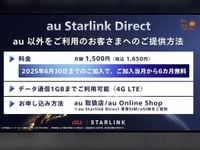KDDI and Okinawa Cellular have announced the expansion of their satellite-to-smartphone direct communication service, "au Starlink Direct," to users of other mobile carriers, including UQ Mobile and povo, starting May 7, 2025. This service, which initially launched for au users on April 10, allows smartphones to connect directly with SpaceX's Starlink satellites, enabling communication even in areas previously considered out of coverage.
The monthly fee for this service is set at 1,650 yen, but for UQ Mobile users on eligible plans, the cost is reduced to 550 yen. Notably, customers who sign up by June 30, 2025, can enjoy six months of free service, making it an attractive option for those in need of reliable communication.
"au Starlink Direct" utilizes existing au frequency bands to facilitate direct communication between smartphones and Starlink satellites. This means that as long as the sky is visible, users can send and receive text messages, access emergency alerts, and share their current location, even in remote areas where traditional networks may fail. The service also includes 1GB of data communication that can be used within the au 4G LTE area.
As of May 7, 2025, the service supports a range of devices, including the Google Pixel 9 series and the iPhone 14, 15, and 16 series, totaling 18 compatible models. Users can apply for the service through au retail stores or the au Online Shop, where they will receive a dedicated au Starlink Direct SIM or eSIM.
KDDI President Hiroto Matsuda highlighted the rapid adoption of the service, stating that during the recent Golden Week holiday, usage surged to nearly 40,000 users in a single day. "We noticed a significant increase in visits to areas that are typically hard to reach, such as Oze and Nikko, where traditional base stations struggle to provide coverage," he explained.
Moreover, the service has garnered interest not only from individual users but also from various corporate sectors, including manufacturing, construction, and finance. Companies have expressed needs for communication solutions in disaster management, particularly for confirming safety during emergencies and maintaining contact in remote locations.
Matsuda emphasized the importance of this service for both personal and corporate users, stating, "We believe in the power of communication itself and have been creating it as a value. Our mission is to continue providing connections and ease of use, especially in the face of the rising demand for data traffic in the AI era."
The launch of "au Starlink Direct" marks a significant step in KDDI's efforts to enhance communication infrastructure across Japan, particularly in regions where connectivity has been a challenge due to the country's unique topography. Despite a population coverage rate exceeding 99.9%, the area coverage remains around 60%, highlighting the need for innovative solutions like satellite communication.
In addition to personal use, KDDI plans to cater to corporate clients by offering solutions tailored to their specific needs, such as monitoring and observation in areas where laying cables is impractical. The company aims to position "au Starlink Direct" as a reliable backup communication method, especially for businesses operating in challenging environments.
As part of its commitment to expanding its service offerings, KDDI is also set to launch a dedicated website on June 3, 2025, where users can explore various use cases of "au Starlink Direct," including maps that illustrate usage trends and scenarios.
With the introduction of this service, KDDI is poised to redefine communication possibilities in Japan, ensuring that as long as the sky is visible, users can stay connected, no matter where they are.






